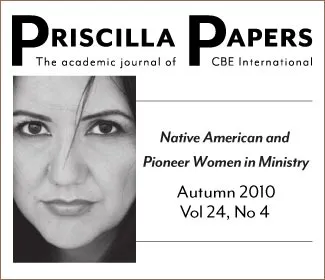The Puritans are not known for their egalitarianism. Indeed, the word “Puritan” instead conjures up images of witch-burning, fun-draining, Quaker-persecuting authoritarians who restricted women to a life of dreary housework and perpetual childrearing. There is some truth to this stereotype. Certainly, the typical Puritan minister viewed women as subordinate beings who needed to keep quiet in church and be submissive to their husbands. As Benjamin Wadsworth noted in a sermon titled The Well-Ordered Family, “The husband is called the head of the woman. It belongs to the head to rule and govern.”1 The cases of Anne Hutchinson and Mary Dyer—strong-willed women who suffered banishment or execution for defying the established order—lend further credence to our stereotypes about the Puritans.2
On the other hand, historians have carefully documented how much of our vision of seventeenth-century New England Puritans incorrectly associates them with nineteenth-century Victorian-era norms and values. The Puritans were relatively open and flexible when it came to sex, for example. Although adultery was a serious crime, church records reveal that fornication was quite common in New England churches and grace was readily extended to those who repented of this sin. Ministers talked openly about sex in their sermons, and husbands and wives celebrated the pleasures of their sexual union in private letters. Furthermore, Puritans drank alcohol often, and in relatively large quantities, and were at least ambivalent, and sometimes downright permissive, when it came to the issue of tobacco smoking.3 Given the fact that the Puritans differed from Victorian norms in these areas, is it possible that the English Puritans of America’s colonial period were actually more egalitarian than our stereotypes about them might presume?
My analysis of records related to Puritan missionary work would suggest that the answer to the above question is “yes.” At least in regard to Christianized Indians, Puritans in New England were open to the idea of women taking an active role in church ministry. Furthermore, interacting with Indians seems to have forced missionaries to rethink some of their basic assumptions about God’s intentions for Christian men and women. Admittedly, there were limitations to this. The Puritans expected that only men would hold formal positions of authority in Native American churches, and they encouraged Indian communities to implement English gender norms in other ways as well. Yet, in spite of this, it is clear that the supposedly stodgy and patriarchal Puritans were, in certain respects, more egalitarian than many evangelicals in today’s world.
Precontact English and Indian gender norms
Before investigating developments in gender norms in early New England, it is worthwhile to examine attitudes toward men and women among English colonists and Indians before they met one another. Clearly, as is the case with all societies, expectations regarding men and women were extremely complex, and there was some variation in opinions among both Indians and the English. Therefore, the following descriptions are generalizations rather than absolute statements about the attitudes of each and every Native American or English colonist.
Although several different tribes, including the Wampanoags, Nipmucs, Narragansetts, and Pequots, lived in New England in 1600, scholars agree that, for the most part, their gender norms were fundamentally similar. Men and women had specific roles and duties in society, and economic functions, in particular, were segregated by gender. Indians in New England tended to view agricultural work, home construction, and clothing manufacturing as women’s work. For men, hunting, fishing, and making tools were appropriate occupations. Native American women shared childrearing responsibilities with grandparents and other relatives. Overall, sexual relationships among Indians were characterized by a degree of autonomy, with divorce being fairly easy for both men and women to obtain.4
Gender not only affected work roles in Native American society, but also shaped spiritual and religious activity. Native Americans in New England felt that women possessed great powers, for through birth they seemingly bestowed the gift of life. Indians valued numerous feminine spiritual figures whom they credited with bestowing life upon humans, plants, and animals. Native Americans accepted women’s dreams as supernaturally inspired, and Europeans accused them of practicing witchcraft, a heresy commonly affiliated with women. This suggests that women played important spiritual roles in Native American society, even if those roles were not always explicitly recorded by European observers. Overall, Indian men and women recognized that each gender was physically and spiritually different, but both genders possessed important specific powers and responsibilities.5
In terms of actual practices, Native American women could actively participate in and lead religious activities, including rituals involving male participants. Indians celebrated, feasted, and played games during their ceremonies. During such occasions, they also composed spiritual songs, sang out loud, and sometimes smoked tobacco, which symbolized thanks or prayers rising to heaven and encouraged hallucinations and forms of spiritual revelation.6
Gender mattered a great deal to the English of the seventeenth century as well, but their sex and gender norms were different from those of New England Indians. Farming was men’s work, and it was expected that men would be the leaders of their households. Men in English society also wielded formal religious and political authority, with few exceptions. Mothers, rather than grandparents or fathers, were primarily responsible for childrearing, and Puritans closely regulated the behavior of women in other spheres of society as well. In addition to childrearing, women processed food, made clothing, assisted other women with childbirth, and sometimes administered medical remedies.7
In terms of marriage and sex, the English had clear expectations. Women were to obey their husbands and love them, while also having the right to expect a measure of love and respect in return. Men, for their part, were supposed to take care of their wives and provide for their material needs. Divorce was nearly impossible to obtain, especially for women, and only in the most extreme and clear cases of spousal abuse could a wife leave her husband.8
Gender shaped English religious life in numerous ways. To the Puritans, there was no doubt that the God of the Bible was male. The King James Bible’s referral to God as Father was to be taken literally, and the fact that Jesus was a male reinforced this belief. Furthermore, one of the ways Puritans distanced themselves from Catholics was by deemphasizing Mary and other feminine figures, doing away with nuns and other female spiritual offices, and ignoring or deemphasizing positive female biblical figures and allegories. To New England Puritans, the most relevant female images from the Bible were Eve, Bathsheba, Delilah, and other seductive or fallen women. Partially for this reason, but also because of how they interpreted 1 Timothy 2:11–12 and other verses in the epistles, only men could lead or speak openly in church settings and at religious gatherings.9
Puritan missionary work, 1620–1740
Before considering an analysis of gender norms as they relate to English missionaries, it is necessary to relate some basic background information about the missionary enterprises themselves. The Puritans organized their churches upon a congregational system in which each church community was designed to be a self-sustaining, autonomous unit. Individual churches were supposed to select and pay their own ministers, and they only infrequently consulted other congregations regarding doctrinal matters or ecclesiastical conflicts.10 This approach did little to address the needs of neighboring Indians, since, unlike Catholics or even other Protestant denominations, the Puritans lacked a bureaucratic structure to allocate funds to missionary efforts or systematically recruit and train missionaries to evangelize Native people. Furthermore, the Puritans hoped and expected that the Indians would eagerly pursue and embrace Christianity on their own, without any need for active proselytization.11
After several decades of fruitlessly waiting for Indians to show up on their church doorsteps, the Puritans in New England realized that, if any conversions were to occur, the Puritans would have to take a more active role in reaching out to neighboring Indians. Consequently, a few individuals began missionary work during the mid 1600s. The most famous of the missionaries was John Eliot, but others, including Richard Bourne, members of the Mayhew family, members of the Cotton family, and William Leverich, also began preaching to Indians. Eventually, an organization known as the Society for the Propagation of the Gospel was set up to collect donations, coordinate work, and start a seminary to train young Indian men for ministerial careers.12
The core strategy employed by the Puritans involved the establishment of “Praying Towns” in which Christian Indians would live apart from both English colonists and other Indians. The idea was to create protected enclaves in which Christian Indians could learn not only about God, the Bible, and the creeds, but also how to live out their daily lives as the English did. The missionaries wanted the Indians to farm, dress, and act like the English, and this included following English gender norms. In order for the Indians to become good Christians, so the thinking went, they had to become “civilized.”13
As scholars have recognized, the English colonists barely achieved even limited success in accomplishing their objectives. Missionaries often expressed frustration and experienced emotional depression as a result of numerous setbacks. Many English, especially in the wake of resentments caused by the wars of the 1600s, opposed the Christianization of Indians, seeing it as a waste of time and resources. Death by disease and disruption caused by war also wreaked havoc in the Praying Towns. Furthermore, not only did many Indians resist Christianization, especially during the 1600s, but, even as more and more Indians became Christianized by the 1700s, they held on to many of their traditions.14 As we shall see, much of this persistence related to the roles of men and women in Indian churches.
Gender in Indian churches
The missionaries partially succeeded in convincing the Indians to follow English gender norms. For example, Indian men, not women, held official positions of leadership in the churches. Only young Indian men attended the seminary at Harvard designed to train new ministers. Christian Indians at least claimed to serve the Puritans’ male God and, according to English sources, expressed a willingness to abandon their former traditions.15
Although certain gender norms were changing in New England Indian communities, evidence also shows that some traditional Indian ideas about men’s and women’s proper roles did not change. It is abundantly clear that Indian gender norms were not, and never became, the same as those of their English neighbors. This included ideas about who could and could not speak at religious gatherings and the degree to which women might hold spiritual authority in and outside the home.16
Available records indicate that, at religious meetings in Christian Indian communities, both men and women spoke openly and asked questions.17 John Cotton, Jr., a missionary who worked on Martha’s Vineyard and near Plymouth during the mid-1600s, recorded some of these questions in his journal. Sometimes, curiosity seems to have motivated these inquiries, while, in other cases, Indians seem to have been challenging certain Puritan teachings.
A careful analysis of questions posed by American Indians reveals their curiosity regarding the place of women within Scripture. On March 20, 1666, William Lay asked Cotton “who was the Queen of the south, and what generation it was that she should condemn, and whether only the bad ones in that generation?”18 This question referred to Matthew 12:42, a passage in which Jesus contrasted the stubborn religious leaders of his day with the Queen of Sheba, who willingly listened to Solomon’s wisdom. On March 5, 1667, Kottoosuck asked about Revelation 17:6, which says, “And I saw the woman drunken with the blood of the saints, and with the blood of the martyrs of Jesus, and when I saw her, I wondered with great admiration.”19 In one case, an Indian man named Towan dared to ask “why was xt [Christ] a man?”20 Such questions indicate that Indians did not quickly forget their traditional value of female icons and spiritual figures. They, unlike their English counterparts, did not simply accept the normative nature of maleness, nor did they see the centrality of male spiritual figures as normative. Whether or not their inquiries altered Cotton’s views of gender remains a mystery, as he never recorded his answers to the Indians’ questions. If he did answer the Indians’ questions adequately, he almost certainly would have had to look up passages that challenged his assumptions regarding the patriarchal nature of Christianity.21
In addition to questioning Cotton regarding female imagery and characters from the Bible, in one instance, Indians inquired about a practical issue related to gender.22 This occurred when Towan asked Cotton, “Why does not God command as much in his word concerning widows as widowers?”23 Apparently, Towan had discovered that several selections from the Bible focused upon the plight of widows and orphans and the need to extend charity to them, but few passages mentioned widowers. The English had little concern for widowers, since men could presumably secure their own material needs.24 For Indians, women provided key economic resources to households, and losing a wife or mother could pose significant challenges to husbands and children.25 In this case, verses found in the King James Bible, from Towan’s perspective at least, failed to address an important need within Indian communities. It is fascinating to speculate whether or not, in response to this difficult question, John Cotton, Jr., emphasized the general Christian principle of extending charity to all those in need, male or female. Or, perhaps more likely, he fell back upon English gender norms and assumed that widowers, whether English or Indian, were naturally capable of taking care of themselves and their families without female aid.
Like Cotton, Experience Mayhew, a missionary who worked on Martha’s Vineyard during the early 1700s, recorded cases of outspoken Indian women. According to Mayhew’s accounts of his services in both Massachusetts and Connecticut in the early 1700s, neither English preachers nor Indian men scrutinized or suppressed the opinions women voiced at religious meetings.26 Although they typically held no official positions of leadership, Indian women taught adults of both genders. Mayhew made many references to such women. Abiah Paaonit “was very Observable for her Forwardness to entertain religious Discourses, and her ability to manage them to the edification of those with whom she conversed.”27 Momchquannum instructed others, especially “young Men and Women, whom she frequently admonished for their Faults, and excited to their Duty.”28 For many English Puritans (and many current evangelicals), it was improper for women to speak so openly or to instruct men, but in Christian Indian communities, the active participation of women was apparently the norm.29
Throughout the 1600s and 1700s, Christian Indian women not only served as spiritual leaders, but also as prophets, healers, and visionaries.30 Such individuals often administered both natural and supernatural remedies to the sick. Although Mayhew did not specifically indicate how Indian healers practiced their arts, it seems reasonable to conclude that they applied a combination of natural and spiritual remedies, perhaps combining Christian and traditional rituals together. As healers, they likely worked on the margins of heterodoxy, operating close to the realm of magic and wonders. This spiritual world was familiar to both Indians and ordinary English colonists, even as educated ministers and elites expressed doubts and suspicions about such supernatural activity.31
In one dramatic instance, Mayhew recorded that the ghost of Elizabeth Pattompan spoke to her father from the grave. She warned him to seek Christ and to write down the words she had uttered just before her death. She also prophesied that he would soon lose all of his material goods and land. The man consulted relatives and friends who advised him to fulfill his daughter’s wishes. Soon afterward, the man lost his property, as his daughter’s spirit had predicted, and he subsequently obeyed her command to live soberly and seek God. Such instances reflect the persistence of certain Wampanoag traditions, most notably the degree of respect given to women and to dreams. Christian Indians combined these traditional values with biblical theology to create a new and dynamic form of spirituality.32
In other cases, Mayhew described miraculous healings that occurred in Christian Indian communities. Japheth Hannit’s mother, who had lost five infants to death, despaired of losing Japheth, her sixth child, in a similar manner. She went out into a field to weep, “but while she was there musing on the insufficiency of human help, she found it powerfully suggested to her mind” that there was one God in the universe who could preserve her son’s life.33 She responded to the vision by seeking Christ, and her son lived. Abiah Paaonit, when ill, went outside at night and “was very suddenly refreshed with a light shining upon and about her.” Mayhew reported that God responded miraculously to the prayers of Christian Indian women in several other instances as well.34
Many Christian Indian men, even after coming under the influence of English gender norms, demonstrated egalitarian leanings. They attentively listened to women at meetings and ceremonies without criticizing or prosecuting them in the way that English men criticized and prosecuted English women. Mayhew said that some women advised their husbands. In one instance, Elizabeth Uhquat spoke “to her Husband giving him the best counsel she could [sic].”35 Men also respected the healing abilities of women and sought out women for healing and prayer when in need. As the story of Elizabeth Pattompan and those of other women suggest, men listened to and obeyed female prophets and storytellers as viable spiritual authorities. Although Christianization influenced gender roles among New England Indians, as other scholars have noted, clearly, Indian men did not adhere to exactly the same patriarchal values that English Puritans did.36 Such accounts lead one to ponder how Indians might have interpreted the Bible in regard to gender without the guidance of Puritans.
Flexible Puritans? The struggle to translate Christianity
It is clear that many Christian Indians in colonial Massachusetts were relatively egalitarian, at least when compared to their English neighbors. But what about the missionaries themselves? What did they think of gender issues after interacting with Indians? Although the evidence suggests that they never became full supporters of equality, it is clear that contact with Indians pushed them to think in new ways about both gender and Christianity.
When Josiah Cotton, son of John Cotton, Jr., decided to become a missionary in the early 1700s, it is unlikely that he thought much about gender and how it might affect the composition of his sermons. But, as the image below illustrates, interacting with Indians required Cotton to wrestle with a variety of issues in new and, from his perspective, unusual ways. Instead of beginning this particular sermon with a statement of doctrine or a moral lesson, as was normally the custom for a Puritan minister, Cotton spent a whole paragraph explaining to his Indian audience how the biblical phrase “sons of men” referred not just to males, but to all humankind. The issue of gendered language caused trouble for Cotton later in the sermon as well. Midway through the document, he wrote the phrase, “Men’s hearts are fully set in them to do evil from atheism.”37 In his text, he crossed out the word “men’s,” but rewrote it, apparently because he was unable to come up with a better, more inclusive term. These sections of his sermon indicate that contact with Indians forced missionaries such as Cotton to confront, and perhaps rethink, some of their assumptions regarding gender and language.
Like Cotton, Experience Mayhew also pondered gender issues as a result of his encounters with New England Indians. When he documented accounts of vocal and dynamic Christian Indian women receiving visions or demonstrating miraculous powers, Mayhew never condemned the women or men for excessive mysticism or superstition. Instead, he simply wrote, “I shall leave these strange occurrences to the thoughts of others, without spending my own judgment on them.” Such statements reflect the tension Mayhew felt when negotiating new theological boundaries in the presence of Christian Indians.38
While missionaries struggled with whether or not it was theologically sound for Indian women to receive visions or prophecy, there is no evidence to suggest that they ever intervened or tried to stop such activities. That is, on a practical level, the missionaries were more open to egalitarianism among Indians. They never incarcerated or punished Indian women for teaching or prophesying, as would be the norm when dealing with English women who engaged in such activities. If anything, missionaries, by answering questions posed by Indian women and publicizing their mystical experiences, affirmed the active role women played in Christian Indian communities. Mayhew, when mentioning a pious woman named Hannah Nohnosoo, said, “I have myself divers times heard her talk very religiously.”39 Even though many of these instances might not be considered preaching, at least in a Puritan sense, even listening to a woman’s opinions at a religious meeting stretched the missionaries’ understanding of proper gender roles.
On the first page of one of Josiah Cotton’s sermon notebooks,
the top portion lists locations and dates where and when
Cotton delivered lessons to Indian audiences. The bottom
portion includes the beginning of the sermon. algonquian
words accompany the English version. The bottom reads, “You
may observe in the text it is said the hearts of ye [the] sons of
men are fully set for evil. It means daughters as well as sons,
ye [the] weaker no doubt if ye [the] stronger sex; no man nor
mother’s child is exempted from this inclination to do evil,
tho in . . . . “ Massachusetts Historical Society, John Davis Papers
collection, used by permission.
Explanations for egalitarianism in early American missions
Even after prolonged contact with English missionaries, Christian Indians maintained many of their traditions, particularly pertaining to women’s roles as healers, prophets, and teachers. As scholars have found among a variety of Indian tribes, gender norms remained remarkably persistent, even in the wake of dramatic changes in other areas of life.40
The persistence of traditional gender norms explains many of the Christian Indians’ views regarding the roles of men and women. It should also be said, however, that, as studious Christians, the Indians found some support for their views in the Bible. Even in non-egalitarian translations, such as the King James, Indians discovered stories about powerful female figures and images, particularly in the books of Matthew and Revelation. They studied diligently, found passages related to gender, and asked honest and thought-provoking questions. They wondered about theoretical and mystical elements of Christianity, but also wanted to understand what the Bible said about the treatment of widows and widowers. The fact that their inquiries predated the women’s movement of the 1960s and 1970s by some three hundred years indicates that interest in what the Bible has to say about gender is not specific to any limited time, place, or historical context. It is a reflection of the universal importance of proper relationships between the genders and of widespread curiosity about what the Bible teaches regarding men and women. In this case, profound interest and piety, rather than a particular political agenda, motivated the questions of Christian Indians in colonial New England.
As for the missionaries, the reasons for their relatively egalitarian stance are less clear. Their tolerance of egalitarianism does not seem to have been rooted in ignorance or benign neglect of Scripture. Clearly, based upon their life histories, these men invested significant amounts of time and energy in their work as missionaries.41 It is not as if they did not care about Indian behavior or beliefs. They also certainly were aware of the egalitarianism in Indian communities, as some of them even publicized the stories in written works. Perhaps the root of their flexibility lay in the many adversities they encountered: resistance from both English colonists and Indians themselves, high rates of mortality in Indian communities, disruption from warfare, language barriers, among others. It seems reasonable to assume that they “picked their battles” when it came to cultural variations and focused upon communicating what they saw as the essential tenets and doctrines of Christianity. Everything else was peripheral. Apparently, the missionaries recognized that it was possible for devout, Bible-based Christianity and egalitarian gender relationships to go hand in hand. Requiring Indians to adhere strictly to English gender norms would do more harm than good to the spread of the gospel, so the missionaries decided to allow for some flexibility. In doing so, they established a legacy of being “relative egalitarians” in regard to missionary work. As other authors have noted, this heritage persisted among American evangelicals throughout the 1800s and 1900s as well.42
Notes
- Benjamin Wadsworth, A Well-Ordered Family (Boston, Mass.: Bartholomew Green, 1712), 35–36.
- Alan Taylor, American Colonies: The Settling of North America (New York, N.Y.: Penguin, 2001), 159–203.
- Records of the West Parish Church in Barnstable, Sturgis Library, Barnstable, Mass., May 4, 1725; Edmund Morgan, “The Puritans and Sex,” New England Quarterly 15 (December 1942): 591–607; William Youngs, Jr., God’s Messengers: Religious Leadership in Colonial New England, 1700–1750 (Baltimore, Md.: Johns Hopkins University Press, 1976), 6–7; James Deetz and Patricia Scott Deetz, The Times of Their Lives: Life, Love, and Death in Plymouth Colony (New York, N.Y.: W. H. Freeman, 2000); Mark Edward Lender and James Kirby Martin, Drinking in America, A History (New York, N.Y.: The Free Press, 1982), 2–21; Andrew Barr, Drink: A Social History of America (New York, N.Y.: Carroll and Graf, 1999), 1–11, 142–43.
- Kathleen Bragdon, Native People of Southern New England, 1500–1650 (Norman, Okla.: University of Oklahoma Press, 1996, 175–78; Larry J. Zimmerman, Native North America (Boston, Mass.: Little, Brown, 1996), 85; Jean M. O’Brien, “‘Divorced’ from the Land: Resistance and Survival of Indian Women in Eighteenth-Century New England,” in Colin G. Calloway, ed., After King Philip’s War: Presence and Persistence in Indian New England (Hanover, N.H.: University Press of New England, 1997), 144–61; Neal Salisbury, Manitou and Providence: Indians, Europeans, and the Making of New England, 1500–1643 (New York, N.Y.: Oxford University Press, 1982), 30–49.
- Bragdon, Native People, 169–230; Ann Plane, Colonial Intimacies: Indian Marriage in Early New England (Ithaca, N.Y.: Cornell University Press, 2000) and “‘The Examination of Sarah Ahhaton’: The Politics of ‘Adultery’ in an Indian Town in Seventeenth-Century Massachusetts,” Annual Proceedings of the Dublin Seminar for New England Folklife 16 (1991): 14–23.
- Bragdon, Native People, 17, 120, 180–81; 218–27; Karna L. Bjorkland, The Indians of Northeastern America (New York, N.Y.: Dodd, Mead, 1969), 119; Neal Salisbury, Manitou and Providence, 30–35.
- Laurel Thatcher Ulrich, Good Wives: Image and Reality in the Lives of Women in Northern New England, 1650–1750 (New York, N.Y.: Random House, 1982); Elizabeth Reis, “The Devil, the Body, and the Feminine Soul in Puritan New England,” Journal of American History 82 (June 1995): 15–36; Carol F. Karlsen, The Devil in the Shape of a Woman: Witchcraft in Colonial New England (New York, N.Y.: W. W. Norton, 1987); Margaret O. Thickstun, Fictions of the Feminine: Puritan Doctrine and the Representation of Women (Ithaca, N.Y.: Cornell University Press, 1988).
- Plane, Colonial Intimacies, 91, 129–30; Ulrich, Good Wives, 110–13.
- David Hall, Worlds of Wonder, Days of Judgment: Popular Religious Belief in Early New England (Cambridge, Mass.: Harvard University Press, 1990), 34–35; Reis, “The Devil, the Body”; Karlsen, The Devil in the Shape of a Woman; Thickstun, Fictions of the Feminine; Ulrich, Good Wives.
- David Hall, The Faithful Shepherd: A History of the New England Ministry in the Seventeenth Century (Chapel Hill, N.C.: University of North Carolina Press, 1972); Francis J. Bremer, Shaping New Englands: Puritan Clergymen in Seventeenth-Century England and New England (New York, N.Y.: Twayne, 1994); Samuel Eliot Morison, Harvard College in the Seventeenth Century, vol. 1 (Cambridge, Mass.: Harvard University Press, 1936), 341.
- Richard Cogley, John Eliot’s Mission to the Indians before King Philip’s War (Cambridge, Mass.: Harvard University Press, 1999), 1–21; James P. Ronda, “Generations of Faith: The Christian Indians of Martha’s Vineyard,” William and Mary Quarterly 38 (July 1981): 369–94; Dane Morrison, A Praying People: Massachusett Acculturation and the Failure of the Puritan Mission, 1600–1690 (New York, N.Y.: Peter Lang, 1995), 37–45; Francis Jennings, “Goals and Functions of Puritan Missions to the Indians,” Ethnohistory 18 (1971): 197–212; Neal Salisbury, “Red Puritans: The ‘Praying Indians’ of Massachusetts Bay and John Eliot,” William and Mary Quarterly 31 (1971): 27–54; Harold Van Lonkhuyzen, “A Reappraisal of the Praying Indians: Acculturation, Conversion, and Identity at Natick, Massachusetts, 1646–1730,” New England Quarterly 63 (1990): 396–428.
- Cogley, John Eliot’s Mission; Morison, Harvard College, 352–60; Morrison, A Praying People; Jennings, “Goals and Functions”; Salisbury, “Red Puritans”; Lonkhuyzen, “Reappraisal.”
- Cogley, John Eliot’s Mission; Ronda, “Generations of Faith”; O’Brien, ‘“Divorced’ from the Land,” 147–57.
- O’Brien, ‘“Divorced’ from the Land”; Morrison, A Praying People; Ronda, “Generations of Faith”; David Silverman, Faith and Boundaries: Colonists, Christianity, and Community among the Wampanoag Indians of Martha’s Vineyard, 1600–1871 (New York, N.Y.: Cambridge University Press, 2005); Douglas Winiarski, “A Question of Plain Dealing: Josiah Cotton, Native Christians, and the Quest for Security in Eighteenth-Century Plymouth Colony,” New England Quarterly 77 (Sept. 2004): 368–413; Daniel Mandell, Behind the Frontier: Indians in Eighteenth-Century Eastern Massachusetts (Lincoln, Nebr.: University of Nebraska Press, 1996).
- Cogley, John Eliot’s Mission; Morison, Harvard College, 352–60; Plane, Colonial Intimacies; O’Brien, ‘“Divorced’ from the Land.”
- O’Brien, ‘“Divorced’ from the Land”; Ronda, “Generations of Faith.”
- Taylor, American Colonies, 199; Silverman, Faith and Boundaries, 49–53; Len Travers, ed. “Notes and Documents: The Missionary Journal of John Cotton, Jr., 1666–1678,” Proceedings of the Massachusetts Historical Society 109 (1997): 52–59.
- Travers, “Notes and Documents,” 61.
- Travers, “Notes and Documents,” 76.
- Travers, “Notes and Documents,” 77.
- Cotton’s journal suggests that he took Indian questions seriously. He studied Scriptures in response to Indian questions, in one instance preaching from Matt. 4:10 a month after an Indian named Joseph asked about the passage. Travers, “Notes and Documents,” 80–81.
- Travers, “Notes and Documents,” 80. In many cases, such gendered language may be more a product of English translators rather than a reflection of the original intent of ancient authors. Recently, some biblical scholars and linguists have challenged translations of certain passages, including 1 Tim. 2, which, according to English translations, apparently restrict the role of women in churches and prevent them from holding leadership positions. In other cases, gender-neutral pronouns in Greek and Hebrew were translated as generic “he” or “him” in older English translations such as the King James and Geneva Bibles used by Puritans and Indians in southeastern Massachusetts. See Joe E. Trull and Audra E. Trull, eds., Putting Women in Their Place: Moving Beyond Gender Stereotypes in Church and Home (Macon, Ga.: Smyth and Helwys, 2003); Catherine and Richard Kroeger, I Suffer Not a Woman: Rethinking 1 Timothy 2:11–15 in Light of Ancient Evidence (Grand Rapids, Mich.: Baker, 1992).
- Travers, “Notes and Documents,” 80.
- Travers, “Notes and Documents,” 77–80; Ulrich, Good Wives, 148; Taylor, American Colonies, 171–72.
- Bragdon, Native People, 169–83; Salisbury, Manitou and Providence, 30–49; Taylor, American Colonies, 188–92.
- Ronda, “Generations of Faith,” 369–94; Silverman, Faith and Boundaries, 49–77; Experience Mayhew, Indian Converts or Some Account of the Lives and Dying Speeches of the Christianized Indians of Martha’s Vineyard in New England (London: J. Osborn and T. Longman, 1727).
- Mayhew, Indian Converts, 159.
- Mayhew, Indian Converts, 161.
- Although women held informal power and were influential in shaping ecclesiastical life in colonial Massachusetts, it is clear that they were not supposed to preach or speak openly in Puritan congregations. Ulrich, Good Wives, 219–35; Marilyn Westerkamp, “Anne Hutchinson, Sectarian Mysticism, and the Puritan Order,” Church History 59 (Dec. 1990): 482–96; David Hall, ed., The Antinomian Controversy, 1636–1638: A Documentary History (Middletown, Conn.: Wesleyan University Press, 1968).
- Mayhew, Indian Converts, 85, 105, 241.
- Richard Godbeer, The Devil’s Dominion: Magic and Religion and Early New England (New York, N.Y.: Cambridge University Press, 1992), 30–32, 61–69; Hall, World of Wonders.
- Bragdon, Native People, 177–78, 190–91; Mayhew, Indian Converts, 238–42.
- Mayhew, Indian Converts, 45.
- Mayhew, Indian Converts, 160.
- Mayhew, Indian Converts, 201.
- Travers, “Notes and Documents,” 68–89; Mayhew, Indian Converts, 241.
- Josiah Cotton, Indian Sermon, in John Davis Papers, Massachusetts Historical Society.
- Mayhew, Indian Converts, 242; Ronda, “Generations of Faith,” 375–86; Hilary Wyss, “Things That Do Accompany Salvation: Colonialism, Conversion, and Cultural Exchange in Mayhew’s Indian Converts,” Early American Literature 33 (1998): 51–52.
- Mayhew, Indian Converts, 165.
- O’Brien, ‘“Divorced’ from the Land”; Plane, Colonial Intimacies, and “The Examination of Sarah Ahhaton”; Theda Purdue, Cherokee Women: Gender and Culture Change, 1700–1835 (Lincoln, Nebr.: University of Nebraska Press, 1998); Ramón A. Gutiérrez, When Jesus Came, the Corn Mothers Went Away: Marriage, Sexuality, and Power in New Mexico, 1500–1846 (Stanford, Calif.: University Press, 1991); Helen C. Rountree, Pocahontas’s People: The Powhatan Indians of Virginia Through Four Centuries (Norman, Okla.: University of Oklahoma Press, 1989).
- Josiah Cotton, Memoirs, Massachusetts Historical Society; Cogley, John Eliot’s Mission; Silverman, Faith and Boundaries; Ronda, “Generations of Faith.”
- Paul W. Chilcote, “Biblical Equality and the Spirituality of Early Methodist Women,” Priscilla Papers 22 (Spring 2008), 11–16; Kathryn Reese Hendershot, “E. Stanley Jones Had a Wife: The Life and Mission of Mabel Lossing Jones, 1878–1978,” Priscilla Papers 22 (Spring 2008), 23–26; Janette Hassey, No Time for Silence: Evangelical Women in Public Ministry around the Turn of the Century (Grand Rapids, Mich.: Academie Books, 1986); Dana Robert, American Women in Mission: A Social History of Their Thought and Practice (Macon, Ga.: Mercy University Press, 1996); Wade Burleson, “Lessons from the Female Cherokee Seminary,” Mutuality 14 (Winter 2007), 8–9; Mimi Haddad, “An Irrepressible Legacy: Women in Ministry Leadership,” Mutuality 14 (Winter 2007), 10–12.





